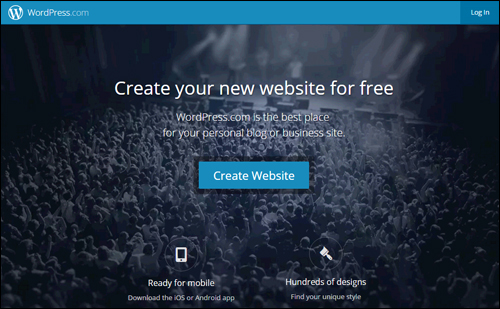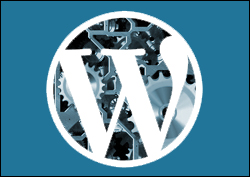
Welcome to Part Three of our Web Traffic Blueprint article series, where we show you how to turn your site into an automated web traffic generation machine using the WordPress CMS platform.
In Part One of this article series, we explained why using an expertly configured WordPress website or blog is the key to generating automated traffic …
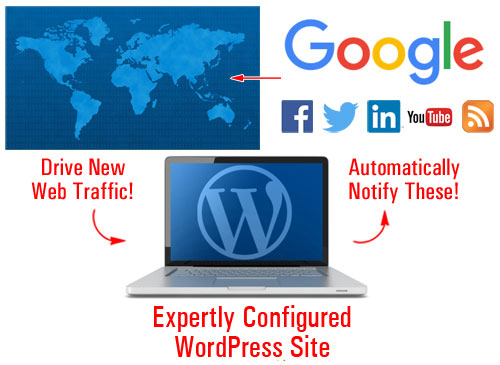
(With an expertly configured WordPress website or blog, all you have to do is publish content on a consistent basis to start driving traffic!)
In Part Two, we focused on critical setup decisions. We helped you understand the best way to start if you don’t have a web presence yet, how to set everything up if you already have a site, and what to do if your website has been built with WordPress.
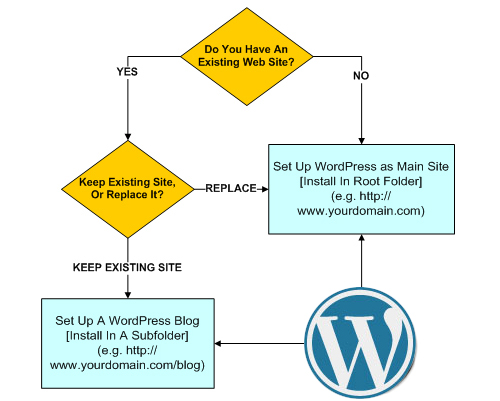
(In Part 2 we show you how to set up a WordPress website or blog on your domain)
In this article, we will look at the configuration stage of the traffic system. We explain how a WordPress site should be configured to ensure that web traffic will automatically start flowing when you begin to add content regularly to your WordPress site.
WordPress Traffic System – Configuration
The ability to drive more traffic to one’s website is often cited by website owners as their greatest challenge online. With business becoming increasingly more competitive on a global scale, it’s worth exploring any and every advantage that can help you get better results online.
Being able to automatically generate traffic on demand can provide website owners with a huge advantage. For WordPress users, an expertly configured website means having a significant advantage from the word “go”.
The Difference Is In The Way Your Site Is Configured
There is a difference between an expertly configured WordPress site and a website that has been professionally installed and set up by a web-building expert but not necessarily configured to take advantage of everything WordPress has to offer.
Here is a simple way to explain the main difference:
With a WordPress website that has been expertly configured you get a professional web presence and an automated online business marketing tool!
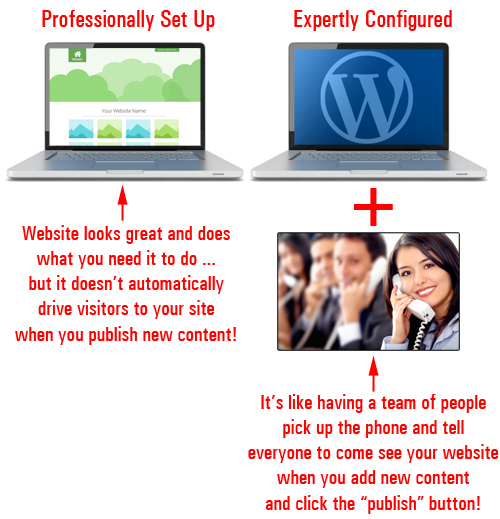
(An expertly configured website gives you a professional web presence with a built-in automated online business marketing process!)
Not only is additional work required to build and integrate an automated online business marketing process into your website, it also takes a special kind of expertise.
Allow me to illustrate this point with a little story.
Knowing Where To Tap
All is humming along in the widget-making factory when everything suddenly just stops.
No one can figure out what’s happened and so the floor manager decides to call in an expert.
Soon afterwards, the expert arrives and, without saying a word, heads out directly to the control box. After staring at the circuit board for no more than 3 minutes or so, the expert then takes out a tiny little hammer and makes a single tap about one cm from the bottom-right corner of the unit.
Immediately, all the machinery springs back to life.
The floor manager is greatly overjoyed as he thanks the expert, who then leaves as quickly as he had arrived.
A couple of days after resolving the incident, the manager receives an invoice for the amount of $5,000.
Feeling furious, the manager calls the expert. Demanding to know why they were charged such a large amount of money for less than five minutes work, he promptly requests an itemized invoice to be sent and hangs up.
The next day, an invoice arrives and is placed in the manager’s in-tray. Upon opening it, this is what he sees:
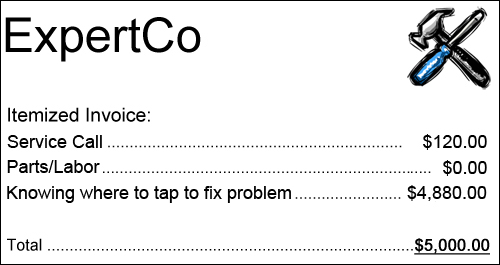
The #1 challenge most businesses face online is being able to drive web traffic to their sites.
How much money did the gizmo factory stand to lose when the machines stopped functioning and no one in the factory floor was able to fix it? Did the expert in our story not have the right to demand fair compensation for years spent acquiring the knowledge and expertise that allowed him to immediately repair a potentially costly problem?
Similarly, if you could have your web site configured so all you have to do is publish new content and Google, Facebook, Twitter, LinkedIn, Pinterest and dozens of other online properties would be automatically notified, how much time and money would this save you?
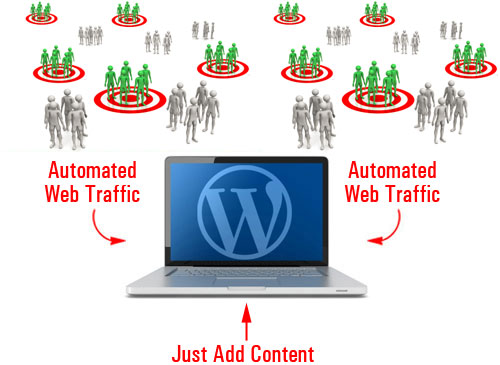
(How much better would your business be if you could automate the process of attracting new visitors to your site?)
Although the solution to many problems can seem ridiculously easy once implemented, it rarely is that simple or easy when you try to figure things out.
Knowing how to expertly configure a WordPress site is more than installing a website and configuring a few internal settings. It involves knowing where to tap! In other words, knowing things such as:
- Which plugins you need to install for specific things to occur on your site.
- Which third-party services need to be set up to get certain results
- Which settings you need to configure to ensure that things will work as expected, etc.
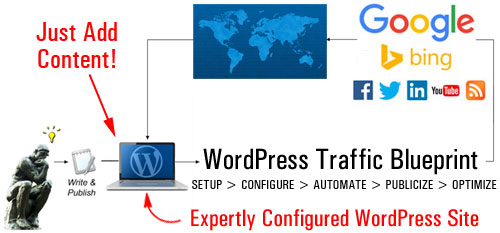
(Generating web traffic automatically with WordPress is a process that requires expertise)
This stage of the WordPress traffic automation system is not technically challenging, but it’s quite involved and time-consuming. The reason why is because it’s not as easy as installing a plugin, clicking a button … it’s all of this and so much more.
Expertly configuring your website is a process that involves your server, your website or blog, and a number of external sites …
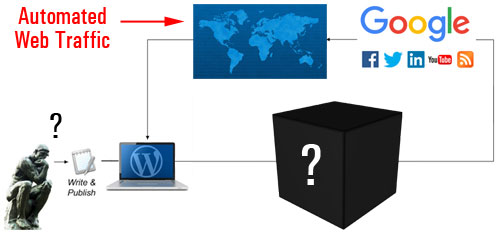
(Expertly configuring your website involves more than just configuring some WordPress settings)
If the steps involved in the configuration process were to be flowcharted, it would look something like this …
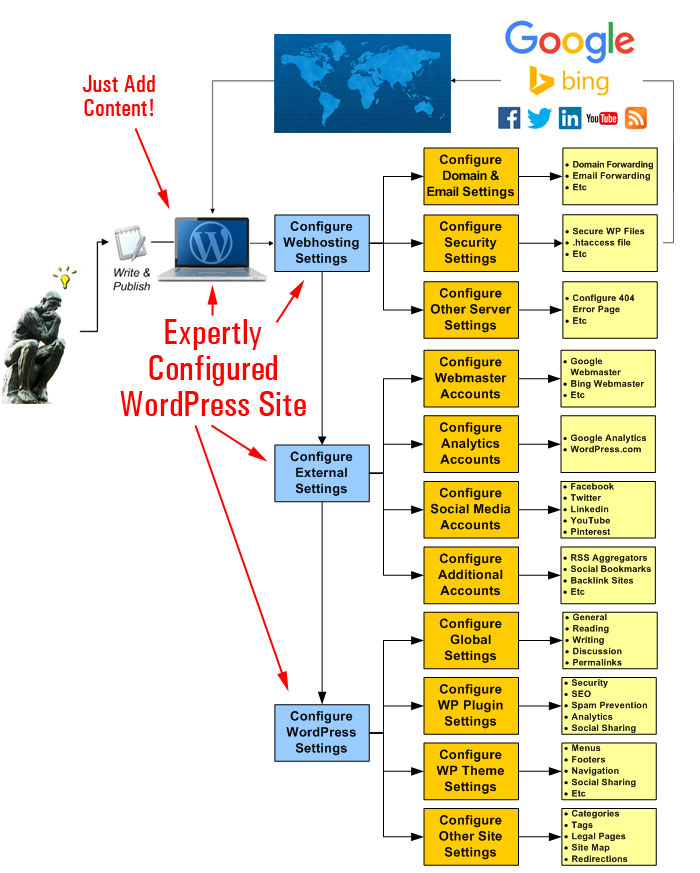
(A simplistic diagram of the configuration phase)
Let’s examine these steps.
Your Web Server – Configuration
We’re not talking here about the process of configuring your web hosting account for site installation purposes (this should have been done during the Setup phase). What we are talking about, is fine-tuning settings and options in your server that affect how you will handle all web traffic …
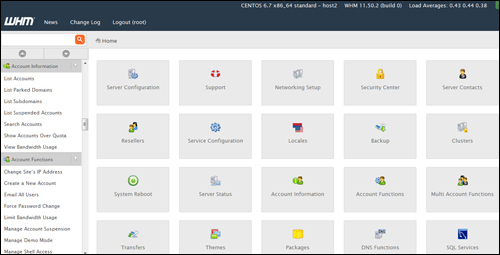
(During the configuration phase, your web-hosting account settings need to be checked for handling both good and bad traffic)
Not all traffic is beneficial traffic. Some of the web traffic you may attract will be unwanted traffic like spam, security threats, bot-hacking attempts, etc.
This area of the configuration process, therefore, is about planning for both good and unwanted traffic and adjusting settings in your server accordingly. This includes looking at things like implementing spam protection and securing server files, to configuring your domain and email forwarding, setting up htaccess and error page redirections, etc …
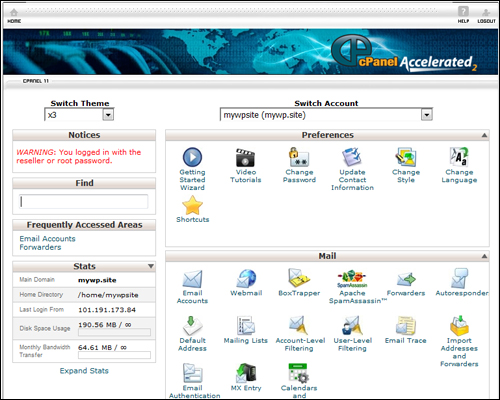
(Have you configured your hosting control panel settings for handling things like emails, page error redirects, etc?)
After fine-tuning your server settings and configuring these (if required), the next step of the configuration phase is to set up various third-party sites and services.
External Sites
The purpose of adding external sites is that all of your content will get published from a central location (your WordPress site) and from there, it will get automatically distributed to other components of your traffic generation system, or notify traffic-related web properties and applications.
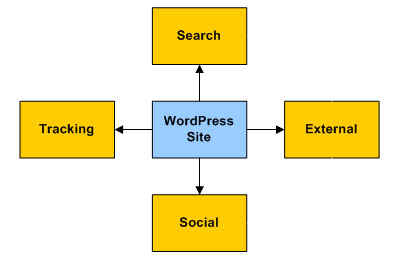
Once you incorporate these external platforms into your setup, content linked back to your site gets automatically added to your search, social and aggregator accounts. Your content and business will be given exposure to new audiences and new sources of traffic.
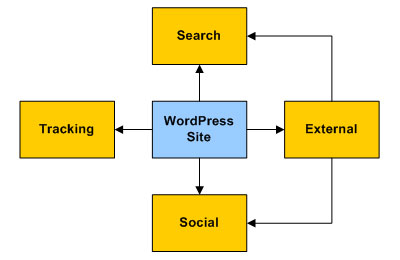
Some of the sites and services will need to be set up before configuring your WordPress site’s settings to speed up the process and some will need to be done later, during the automation phase.
For example, here are just some of the accounts you will need to have set up:
Google Webmaster Tools
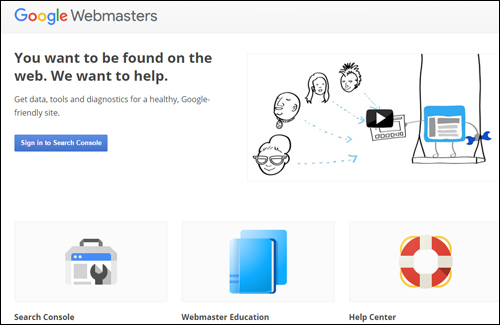
(Google Search Console – create a Google-friendly website or blog)
Google Webmaster Tools lets you tell Google about your site’s pages, submit XML sitemaps for faster page indexing, and provides you with important data, SEO tools and reports about your website.
Once your account is with Google are set up, this information can be used to integrate and automate web traffic-related settings and notifications in WordPress using plugins like Yoast SEO and other applications.
Google Analytics
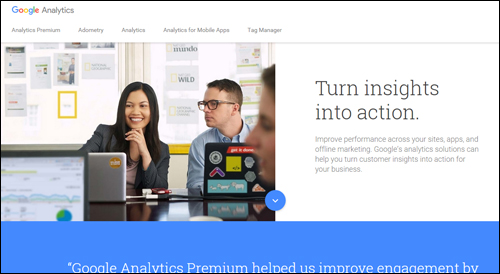
(Google Analytics)
Google Analytics lets you improve your website’s traffic performance, SEO, user engagement, marketing campaigns, and more, by tracking all user engagement, pages visited, keywords searched for, search engine and organic referrers, etc.
Once your Google Analytics account is set up, tracking code can be added to all of your pages in WordPress via a simple plugin used with other applications.
Bing Webmaster Tools
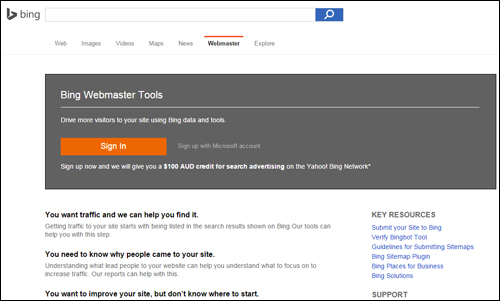
(Bing Webmaster Tools)
Bing Webmaster Tools is similar to Google Search Console. Once your Bing Webmaster Tools account is set up, this information can be used to integrate and automate traffic-related settings in WordPress using plugins like Yoast SEO and other applications.
WordPress.com
(WordPress.com)
As explained in Part 2, WordPress provides users with the option of a hosted vs self-hosted website. We recommended choosing the self-hosted WordPress platform if you plan to grow a professional online presence for your business.
WordPress.com (the hosted option), however, provides a number of useful tools, which a number of WordPress plugins can access. We recommend setting up an account with WordPress.com, therefore, and we’ll explain how to integrate this into your traffic generation system in the next installment of this series.
Social Media And Social Bookmarking

(Syndicate your content automatically to your social media sites and drive new visitors to your site)
You will need your various social accounts set up in order to configure these as part of your traffic generation system.
After setting up and configuring everything, you will be able to syndicate your content automatically to your social media and social bookmarking accounts and bring new visitors to your site.
You should have accounts and pages set up with all of the well-known social networks – Facebook, Twitter, Pinterest, LinkedIn, YouTube, etc.

There are lots of social bookmarking sites you can You can syndicate your content to loads of social sites. You don’t need to create accounts with all of them, just choose the ones that will work well with your setup and/or content sharing tools (we cover some of these tools in more detail further below and during the Automation phase).
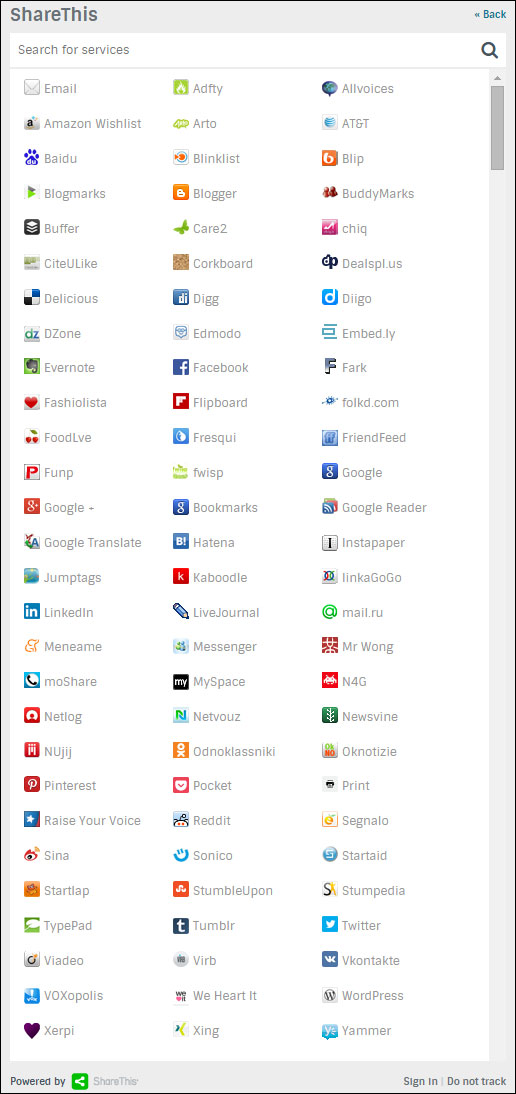
(There are many social sites you can post your content to. Image source ShareThis.com)
Additional Sites, RSS Aggregators, Etc.
There are many new online technology platforms and content aggregators that can serve as secondary traffic generation sources. Some are free or provide free accounts, and some offer a range of pricing plans to suit different user types.
For example, here is a content aggregator that lets you add an RSS feed from your site …
RebelMouse
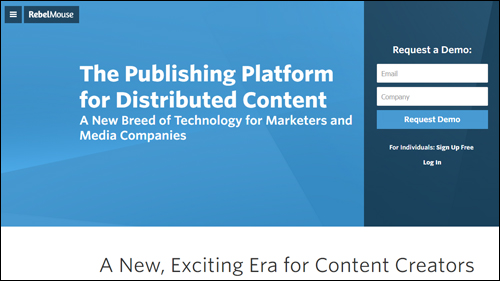
(RebelMouse – Publishing platform for distributed content)
RebelMouse is an aggregator for your RSS feeds and social profiles. Your content is displayed in a Pinterest-like format and visitors can follow your account.
![]()
There are many different platforms you can add to your web traffic blueprint. Please feel free to contact us if you would like to explore this area further and discuss a configuration strategy to suit your needs.
After you have configured your web server and set up accounts with third-party sites, it’s time to configure your WordPress settings.
WordPress Site Configuration
The first step in configuring your site for traffic is to ensure that its global settings have been set up correctly.
Let’s go over some of the important areas.
WordPress – Global Settings
By default, WordPress includes a Settings section that allows you to modify your site’s global settings …
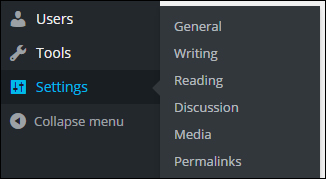
(WordPress dashboard menu – Settings)
General Settings
Fields like Site Title and Tagline can influence your site’s SEO, search listings, etc …
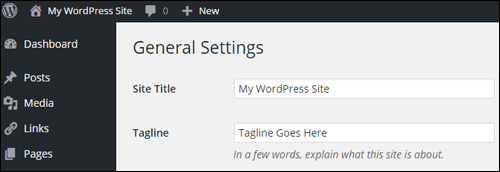
(Settings Menu – General Settings)
Writing Settings
The Writing Settings area contains an important and frequently overlooked traffic notification system …
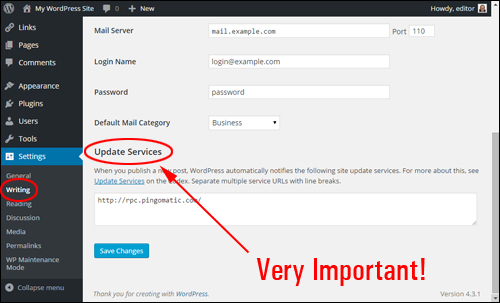
(Global Settings – Writing Settings)
As stated in the Update Services section,
When you publish a new post, WordPress automatically notifies the following site update services …
Unless you have intentionally chosen to discourage search engines from indexing your site, then your site will automatically ping the services entered into the Update Services text box
With an ‘out of the box’ WordPress installation, this section includes only one entry …
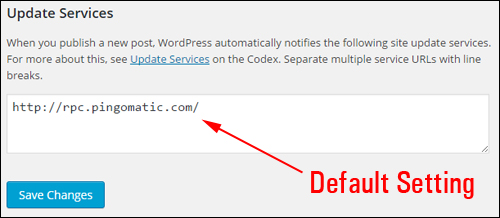
(Update Services)
You can notify dozens of update services automatically …
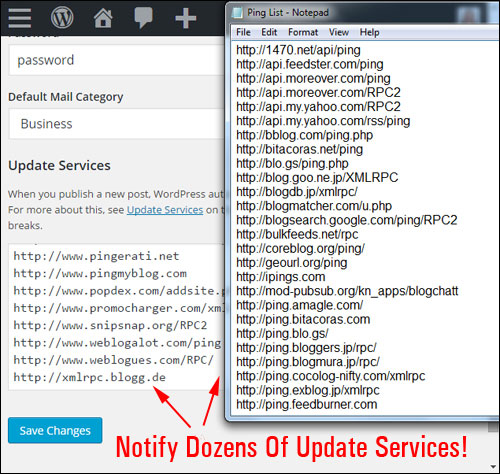
(WordPress lets you notify dozens of update services automatically!)
![]()
Download A Comprehensive List Of Ping Services For Your WordPress Site!
Click the link below to download a comprehensive list of reliable and authoritative ping services for your WordPress site or blog:
Download A List Of Ping Services For Your WordPress Site
***
Note: If you need help setting up the list of ping services on your site, we recommend using a professional web services provider. You can find professional WordPress service providers in our WordPress Services Directory.
Reading Settings
This section affects how your content gets seen by visitors when they visit your home page and blog pages.
The syndication settings in this section can have an influence web traffic. For example, choosing to display the full text vs a summary of your post, affects how your content displays to users in RSS readers and RSS email campaigns, and could play a part in someone’s decision to explore your site further, and whether or not they will visit your website or blog to read the rest of the content from summaries, or read the content in full without the need to click through to your site.
The most important setting here as far as your traffic system is concerned is whether the Search Engine Visibility feature is ticked or not.
Generally, you want search engines to visit your site. Leaving this box unchecked enables WordPress to automatically notify all the update services you have specified in the Update Services box whenever a new post is published (see Writing Settings above). Unless you have a specific reason why search engines should not visit your site, make sure this box is left unchecked …
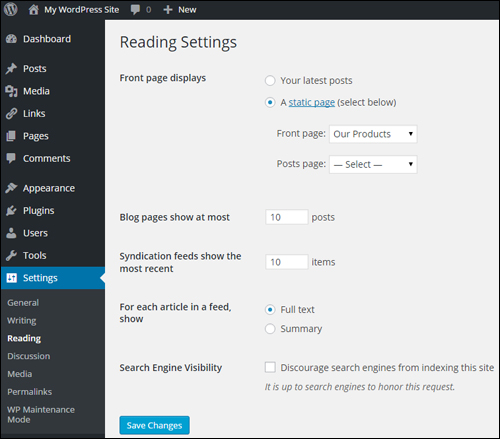
(Global Settings – Reading Settings)
Discussion Settings
Although this section is mostly concerned with how users engage with content on your site, you have the option to allow notifications to sites linked to from your articles, and to allow link notifications from other blogs (pingbacks and trackbacks). This can work for you, but it can also drive bad traffic in the form of SPAM comments …
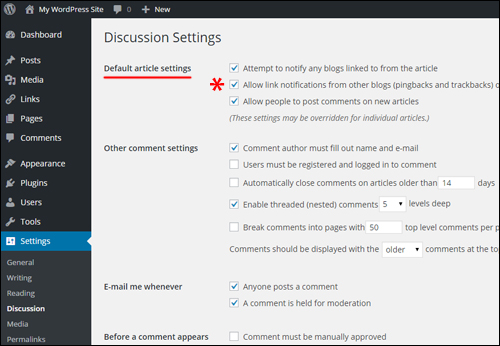
(WordPress Settings – Discussion Settings)
Permalinks
Permalinks allow you to create search engine-friendly URLs …
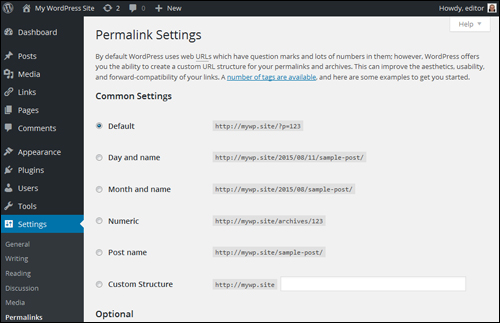
(Global Settings – Permalink Settings)
Here are some of the ways your post permalinks can be configured …
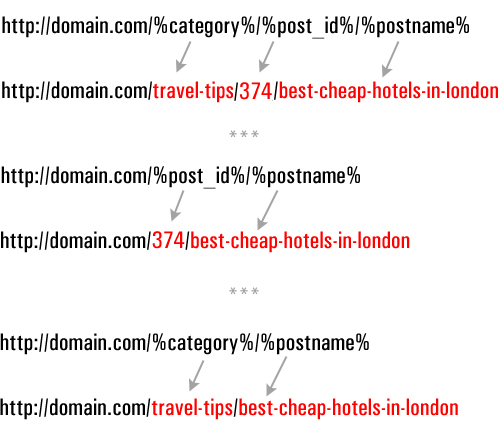
(Configuring post permalinks)
To learn more about setting up permalinks in WordPress, refer to this step-by-step tutorial: How To Change Your WordPress Permalinks
WordPress Traffic Plugins
The WordPress developer community makes available thousands of plugins that help to add just about every kind of functionality to your website, including plugins that add traffic generation capabilities.
Here are examples of plugin categories and plugins that can help to increase traffic
Security Plugins – Blog Defender
Once again, it’s important to configure your website for handling both good traffic and bad traffic. No blog is immune from a cyber-attack.
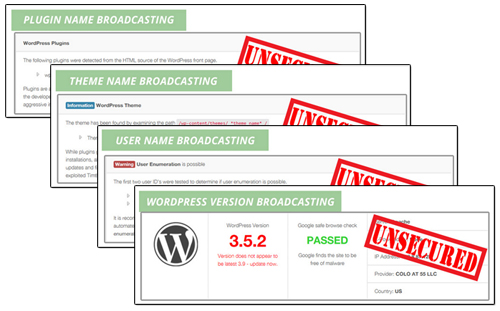 (Security Plugins stop bad traffic from causing your website harm)
(Security Plugins stop bad traffic from causing your website harm)
Security plugins like Blog Defender help to make your WordPress site invisible to bots and hackers.
More information:
WordPress SEO Plugins – Yoast SEO
WordPress SEO plugins help drive more traffic by improving improving the way search engines like Google find and index your website …

(WordPress SEO plugins help drive more traffic by making your site more search engine friendly)
A plugin like Yoast SEO can improve your website’s SEO. When properly configured, this plugin not only makes your site easier for search engines to index, it also gives you control over how your content is displayed in Google’s search results and social media sites Twitter, Facebook, and GooglePlus.
Social Sharing Plugins
Allowing visitors to easily share your content with members of their social communities can help boost traffic to your site, especially if you post great content that adds real value to readers.

(You can easily add social sharing buttons to your site with free or inexpensive plugins)
WordPress users can easily add social features to their website with free or inexpensive WordPress plugins.
Many social plugins let you select which sites visitors can share your content to, embed social buttons into your content, set up custom notifications, display/hide share counters (e.g. number of likes), etc. Some social plugins even allow you to ‘lock’ content or downloads which users can unlock by liking your page.
Themes
As well as configuring various plugins, many WordPress themes also include features that help you drive more traffic to your site.
For example, as well as options and settings for configuring the design and layout of your website, many themes also include built-in options for improving SEO and site navigation structure for better indexing, add analytics, social sharing buttons, etc …
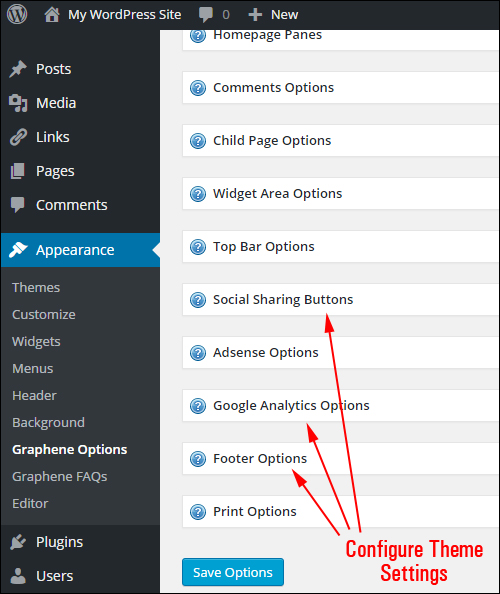
(Many themes have built-in traffic optimization features)
With a number of quality themes, adding social sharing buttons to your content is as easy as selecting the option to enable this functions …

(Many WordPress themes come with built-in social sharing features)
Other Areas To Configure
Last (but by no means least) in the configuration process, are the components that need to be configured outside of the global settings.
This includes:
Website Legal Pages
Once again, when preparing your website for a growth in traffic numbers, it’s important to plan not only for both good and unwelcome traffic but also for all the situations that can damage your business when more and more people start finding and visiting your website.
If you engage in any form of commercial activity online, it’s important that your site remains compliant with legal requirements of government agencies that regulate business practices online.
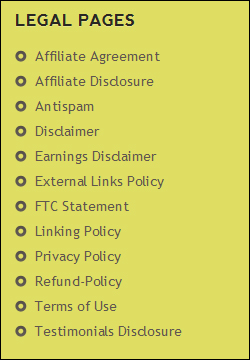 (Does Your Site Comply With All Legal Requirements?)
(Does Your Site Comply With All Legal Requirements?)
If you need help understanding how to quickly add all necessary legal pages to your website, refer to this article:
WordPress Tags And Categories
WordPress categories & tags help to improve your site’s SEO, which improves traffic.
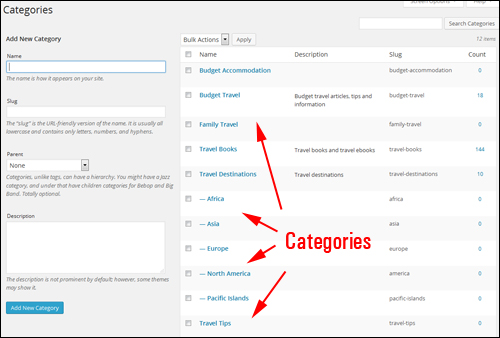
(Categories help to improve your site’s search engine optimization, which improves traffic.)
As we strongly recommend in this article, your site’s post categories and tags should be set up earlier on, during the Website Planning Stage.
In the configuration phase, you will want to review and make sure that your site’s post tags and categories have been correctly set up to deliver optimal benefits.
Site Map
A site map that displays all of your pages and posts is not only a useful navigation tool, it can also help external tools discover your website content …
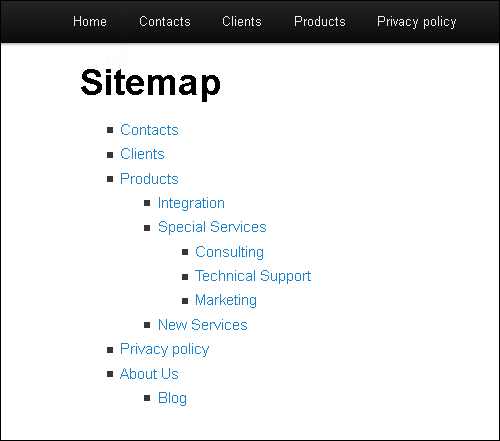
(Site Map – great for site visitors and beneficial for web traffic too!)
![]()
An HTML site map and an XML sitemap are not the same things. An HTML site map is a web page that links to all other content on your site, whereas an XML sitemap contains code that only search engines can read. Although search engines like Google can index your site just from an XML sitemap (which a plugin like Yoast SEO will create for you – see earlier section), allowing visitors to find more pages on your site results in increased traffic.
Your WordPress 404 Error Page
When visitors searching online for your site type in the wrong URL or click on a hyperlink pointing to a destination on your site that no longer exists, they are greeted with a 404 Not Found error page …
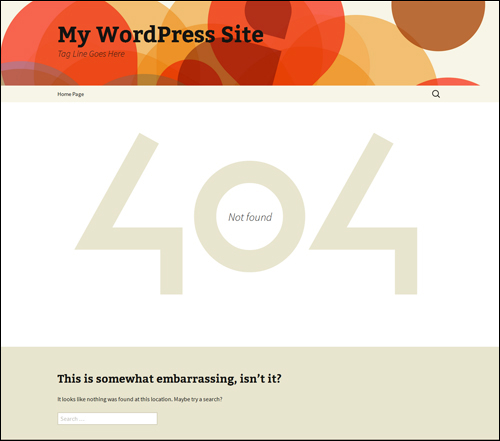
(A 404 Not Found error page)
A 404 page can redirect confused visitors to your functional pages …
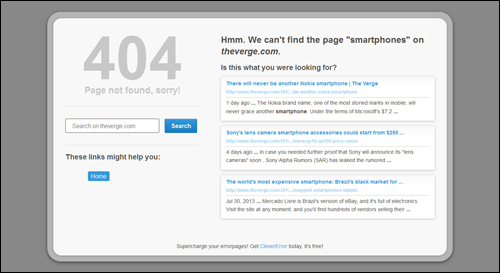
(Configuring your 404 Error Page allows you to recover web traffic that may otherwise be lost.)
![]()
Although a 404 error page can be set up in your server, there are plugins for WordPress that allow you to easily configure your 404 page inside your WordPress dashboard.
WordPress Traffic Blueprint: Configuration Phase – Summary
Once you have your website or blog fully set up and expertly configured, all you then need to do is publish content on a consistent basis to automatically start generating new traffic.
The process of expertly configuring a WordPress site, however, can be quite involved , requiring the configuration and integration of various components and external web properties …
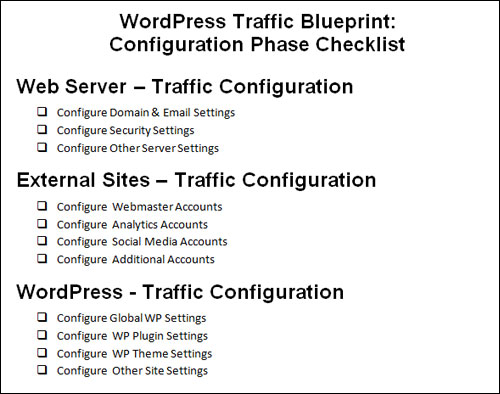
(WordPress Traffic Blueprint – Configuration Phase Checklist)
![]()
The kind of expertise required to perform the configuration stage of the traffic automation process can take some website professionals months to acquire.
Once you have expertly configured your WordPress site, the next step is to automate the process. This step is addressed in the next section of our series.
This is the end of Part 3
To continue reading this article, click on the link below:

![]()
This article is part of a comprehensive series of tutorials designed to help you learn how to grow your business and drive traffic sustainably with a WordPress website and proven marketing methods that are easy to implement.
Subscribe To WPCompendium.org And Get Notified Of New WordPress Tutorials!
***
"This is AMAZING! I had learnt about how to use WordPress previously, but this covers absolutely everything and more!! Incredible value! Thank you!" - Monique, Warrior Forum
***

